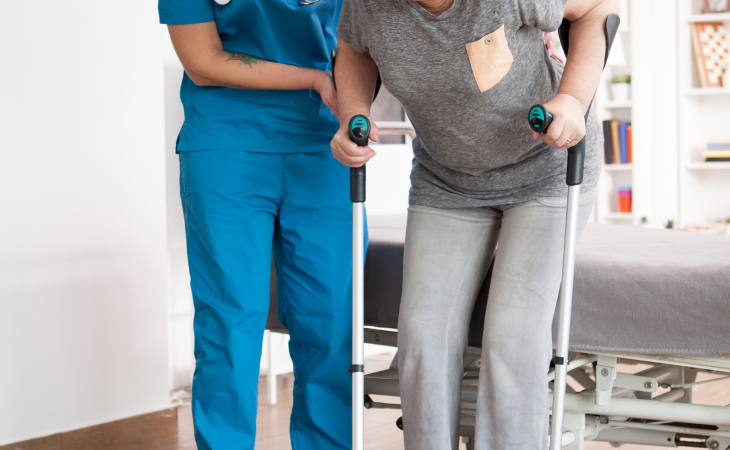
crutches
If an injury or surgical procedure requires you to keep your weight fof your leg or foot, you may have to use crutches. The top of your crutches should reach to 1-1 1/2 inches below your armpits while you stand up straight. The handgrips of the crutches should be even with the top of your hip line. Your elbows should bend a bit when you use the handgrips. Hold the top of the crutches tightly to your sides, and use your hands to absorb the weight. Don’t let the tops of the crutches press into your armpits.
Walking:
Lean forward slightly and put your crutches about one foot ahead of you. Begin your step as if you were going to use the injured foot or leg, but shift your weight to the crutches instead of the injured foot. Your body swings forward between the crutches. Finish the step normally with your non-injured leg. When the non-injured leg is on the ground, move your crutches ahead in preparation for the next step. Keep focused on where you are walking, not on your feet.
Sitting:
Back up to a sturdy chair. Put your injured foot in front of you and both crutches in one hand. Use the other hand to feel for the seat of your chair. Slowly lower yourself into it. Lean your crutches upside down in a handy location. (Crutches tend to fall over when they are stood on their tips.) To stand up, inch yourself to the front of the chair. Hold both crutches in the hand on your good leg side. Push yourself up and stand on the good leg.
Stairs:
To walk up and down stairs with crutches, you need to be both strong and flexible. Facing the stairway, hold the handrail with one hand and tuck both crutches under your armpit on the other side. When you’re going up, lead with your good foot, keeping the injured foot raised behind you. When you’re going down, hold your injured foot up in front, and hop down each stair on your good foot. Take it one step at a time. You may want someone to help you, at least at first. If you’re facing a stairway with no handrails, use the crutches under both arms and hop up or down each step on your good leg, using more strength. An easier way is to sit on the stairs and inch yourself up and down each step. Start by sitting on the lowest stair with your injured leg out in front. Hold both crutches flat against the stairs in your opposite hand. Scoot your bottom up to the next step, using your free hand and good leg for support. Face the same direction when you go down the stairs this way.
Canes
You may find it helpful to use a cane if you have a small problem with balance or instability, a minor weakness in your leg or trunk, an injury or pain. If you are elderly, a single point cane may also help you to keep living independently. The top of your cane should reach to the crease in your wrist when you stand up straight. Your elbow should bend a bit when you hold your cane. Hold the cane in the hand opposite the side that needs support.
When you walk, the cane and your injured leg swing and strike the ground at the same time. To start, position your cane about one small stride ahead and step off on your injured leg. Finish the step with your normal leg. To climb stairs, grasp the handrail (if possible) and step up on your good leg first, with your cane in the hand opposite the injured leg. Then step up on the injured leg. To come down stairs, put your cane on the step first, then your injured leg, and finally the good leg, which carries your body weight.
Walkers
If you’ve had total knee or hip joint replacement surgery, or you have another significant problem, you may need more help with balance and walking than you can get with crutches or a cane. A pickup walker with four solid prongs on the bottom may give you the most stability. It lets you keep all or some of your weight off your lower body as you take your steps. You use your arms to support some of the weight. The top of your walker should match the crease in your wrist when you stand up straight. Don’t hurry when you use a walker. As your strength and endurance get better, you may gradually be able to carry more weight in your legs.
First, put your walker about one step ahead of you, making sure the legs of your walker are level to the ground. With both hands, grip the top of the walker for support and walk into it, stepping off on your injured leg. Touch the heel of this foot to the ground first, then flatten the foot and finally lift the toes off the ground as you complete your step with your good leg. Don’t step all the way to the front bar of your walker. Take small steps when you turn. To sit, back up until your legs touch the chair. Reach back to feel the seat before you sit. To get up from a chair, push yourself up and grasp the walker’s grips. Make sure the rubber tips on your walker’s legs stay in good shape. Never try to climb stairs or use an escalator with your walker.
Other general guidelines for using walking aids around the house include:
-
Remove scatter rugs, electrical cords, spills and anything else that may cause you to fall.
-
In the bathroom, use non-slip bath mats, grab bars, a raised toilet seat and a shower tub seat.
-
Simplify your household to keep the items you need handy and everything else out of the way.
-
Use a backpack, fanny pack, apron or briefcase to help you carry things around.
Quick Contacts
Please feel free to contact us for any inquiry
- Emergency call : +91 94274 18181
- Email : contact@trishahospital.com
- Location: Trisha multispeciality hospital, Ahmedabad



